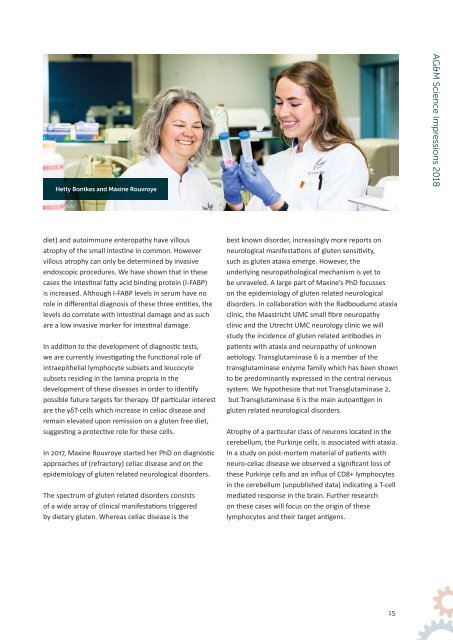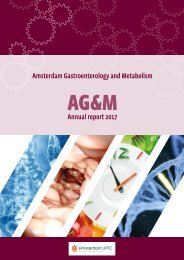AG&M annual report 2018
Create successful ePaper yourself
Turn your PDF publications into a flip-book with our unique Google optimized e-Paper software.
Hetty Bontkes and Maxine Rouvroye<br />
AG&M Science Impressions <strong>2018</strong><br />
diet) and autoimmune enteropathy have villous<br />
atrophy of the small intestine in common. However<br />
villous atrophy can only be determined by invasive<br />
endoscopic procedures. We have shown that in these<br />
cases the intestinal fatty acid binding protein (I-FABP)<br />
is increased. Although I-FABP levels in serum have no<br />
role in differential diagnosis of these three entities, the<br />
levels do correlate with intestinal damage and as such<br />
are a low invasive marker for intestinal damage.<br />
In addition to the development of diagnostic tests,<br />
we are currently investigating the functional role of<br />
intraepithelial lymphocyte subsets and leucocyte<br />
subsets residing in the lamina propria in the<br />
development of these diseases in order to identify<br />
possible future targets for therapy. Of particular interest<br />
are the γδT-cells which increase in celiac disease and<br />
remain elevated upon remission on a gluten free diet,<br />
suggesting a protective role for these cells.<br />
In 2017, Maxine Rouvroye started her PhD on diagnostic<br />
approaches of (refractory) celiac disease and on the<br />
epidemiology of gluten related neurological disorders.<br />
The spectrum of gluten related disorders consists<br />
of a wide array of clinical manifestations triggered<br />
by dietary gluten. Whereas celiac disease is the<br />
best known disorder, increasingly more <strong>report</strong>s on<br />
neurological manifestations of gluten sensitivity,<br />
such as gluten ataxia emerge. However, the<br />
underlying neuropathological mechanism is yet to<br />
be unraveled. A large part of Maxine’s PhD focusses<br />
on the epidemiology of gluten related neurological<br />
disorders. In collaboration with the Radboudumc ataxia<br />
clinic, the Maastricht UMC small fibre neuropathy<br />
clinic and the Utrecht UMC neurology clinic we will<br />
study the incidence of gluten related antibodies in<br />
patients with ataxia and neuropathy of unknown<br />
aetiology. Transglutaminase 6 is a member of the<br />
transglutaminase enzyme family which has been shown<br />
to be predominantly expressed in the central nervous<br />
system. We hypothesize that not Transglutaminase 2,<br />
but Transglutaminase 6 is the main autoantigen in<br />
gluten related neurological disorders.<br />
Atrophy of a particular class of neurons located in the<br />
cerebellum, the Purkinje cells, is associated with ataxia.<br />
In a study on post-mortem material of patients with<br />
neuro-celiac disease we observed a significant loss of<br />
these Purkinje cells and an influx of CD8+ lymphocytes<br />
in the cerebellum (unpublished data) indicating a T-cell<br />
mediated response in the brain. Further research<br />
on these cases will focus on the origin of these<br />
lymphocytes and their target antigens.<br />
15



